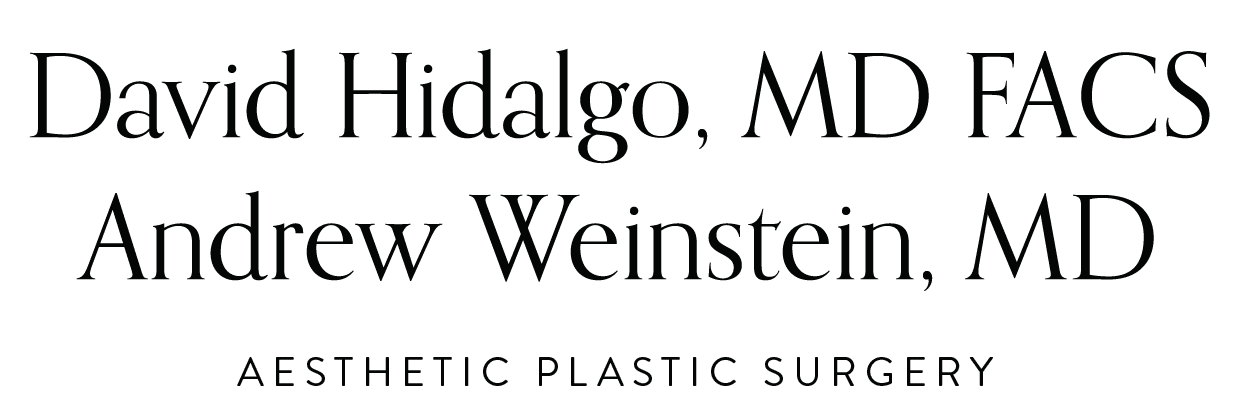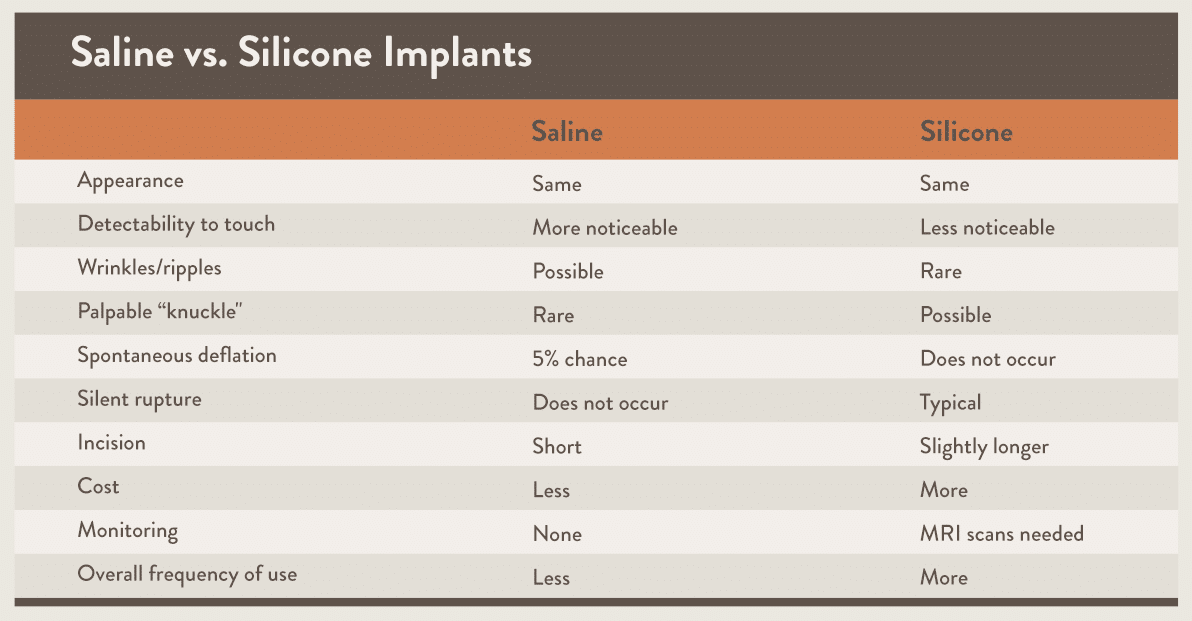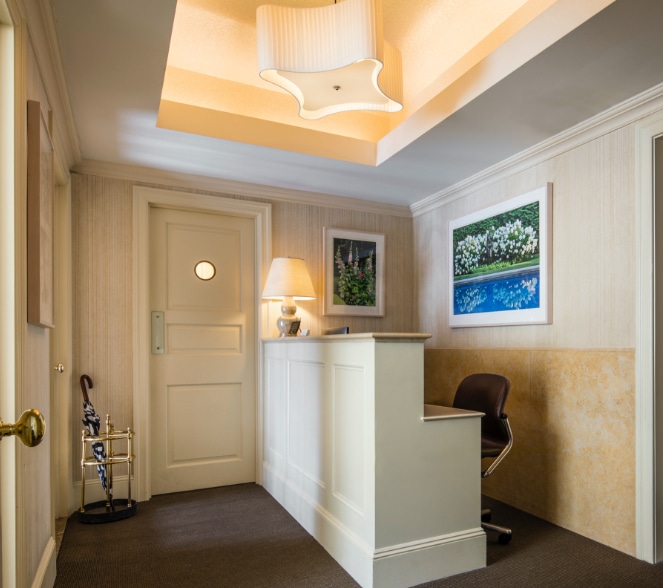Breast Augmentation
Who is a candidate for breast augmentation?
Breast augmentation improves body image and self-confidence. It can resolve clothing issues such as the need to wear padded bras and problems with swimwear. The best candidates are women whose breasts have an attractive shape to begin with but are just smaller than desired (Figure 1). Women who have had multiple pregnancies and breast fed their children are also good candidates for breast augmentation (Figure 2). The breasts typically appear “deflated” in these cases but the natural breast shape is still good. Placing an implant restores volume and shape. The size selected should be more conservative in these women because the skin has more of a tendency to stretch with the added implant weight. Women with almost no breast tissue and no crease definition under the breasts are also good candidates for breast augmentation (Figure 3). The end result in these patients is one in which the breasts look more round, reflecting the shape of the implants that have little breast tissue to conceal them. Nevertheless, these patients are among the most satisfied because they typically experience the greatest degree of positive change in body image.
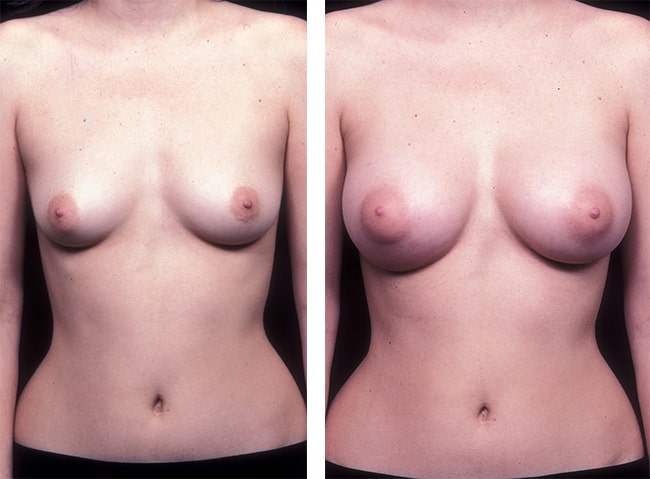
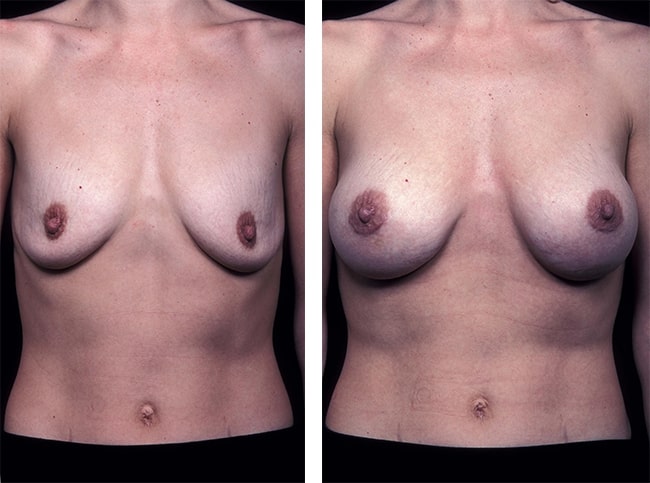
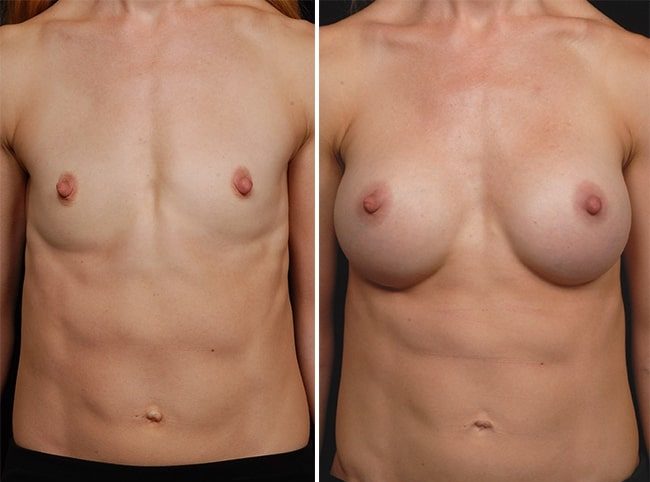
Some breast shapes present a greater challenge. These include breasts that droop downward to various degrees, a condition called ptosis (pronounced “toe-sis”). Breast augmentation alone is often sufficient to achieve an excellent result in these cases (Figure 4). Other times a lift that entails significant scars must be added in order to achieve the best result possible (Figure 5). Another example is women who have a short distance between the bottom of the areola and the crease under the breast (Figure 6). Expanding the lower breast skin sufficiently to achieve a natural result can prove difficult. It sometimes requires using a smaller implant than desired in order to avoid creating shape abnormalities in these cases. Besides these there are many other challenging shapes that require specific and custom solutions for breast augmentation.
Sometimes the breasts are very uneven to begin with. This problem is often simply solved by placing two different size implants. Adding a lift on one side may be necessary when the breast positions differ significantly.
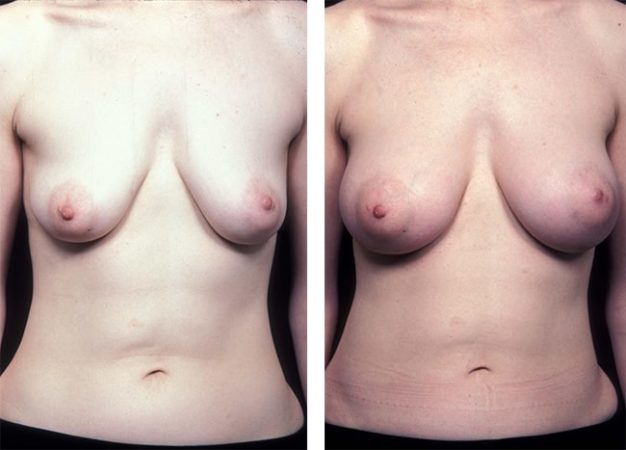
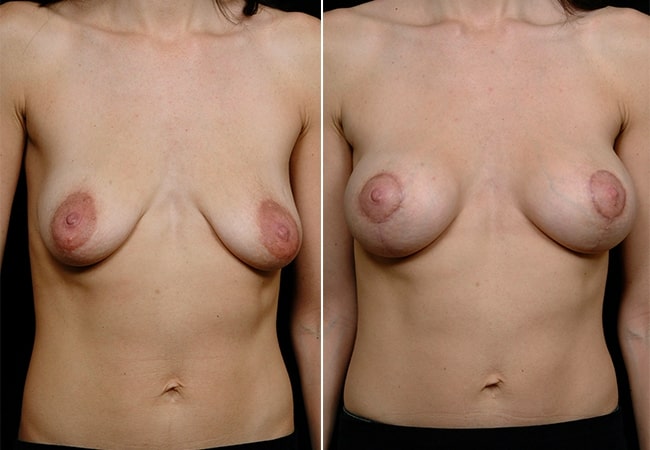
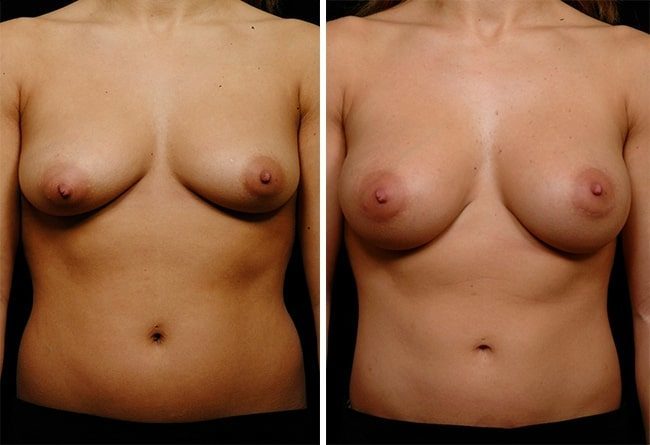
There are some psychological and social aspects that also determine suitability for breast augmentation. Women with psychological problems who are on medication are less likely to be satisfied with their results. The procedure should not be undertaken with the hope that it will improve an unstable relationship, nor should it be pursued primarily to assist in the pursuit of new relationships.
Will breast augmentation make breasts look higher, closer together, and not point outward?
Some women have breasts that are either naturally positioned low on the chest or have a very long torso that makes it appear this way (Figure 7). While breast augmentation can make the breasts larger and improve shape, it cannot fundamentally raise the breast position. The breasts will still look low on the chest, something that surgery cannot change.
Breast augmentation will make the breasts look closer together in almost all women because implants increase the diameter of the breast in all directions (Figure 8). Generally speaking, the larger the implant the closer together the breasts will appear. However, women who have either very wide chests, small diameter breasts, or both, will have a much more limited result in this respect. The breasts may still seem farther apart than desired after surgery.
Some women have breasts that point more to the side than straight ahead. These women typically have more of a round rather than rectangular shape to the underlying chest wall. This platform upon which the breast sits is responsible for the outward turning of the breasts. Breast augmentation will not improve but instead may magnify this issue despite achieving an excellent overall result (Figure 9).
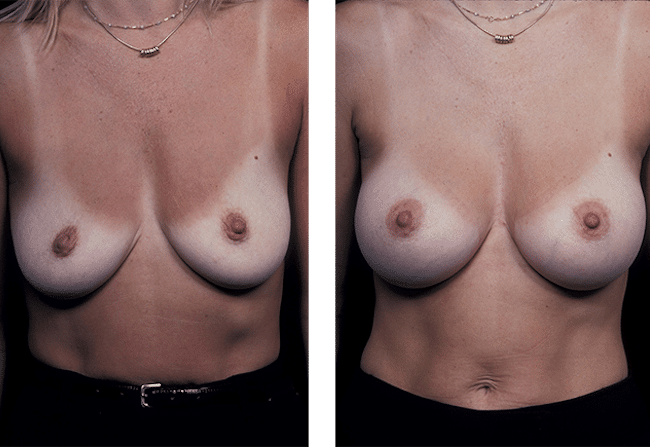
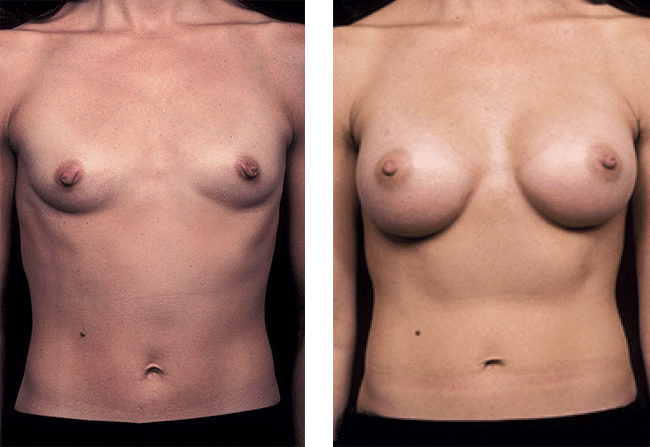
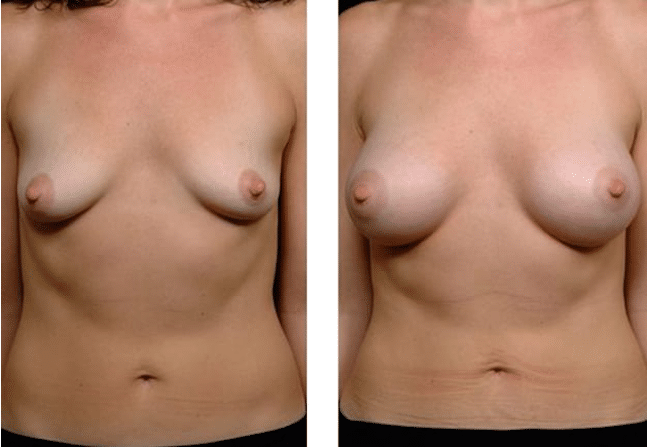
What type of implant is best?
Saline vs. Silicone – Similarities
Both saline and silicone implants are approved by the FDA for breast augmentation. Both are available in a wide variety of sizes and shapes, and both are available with either a rough or smooth surface texture.
Both saline and silicone gel implants have the same outer shell made of solid silicone plastic. The shell itself has not been a source of controversy. Silicone is one of the most biologically inert substances known. The filler material used in silicone implants today is a cohesive gel that has a jello-like consistency compared to the liquid form used in earlier generation implants (Figure 10).
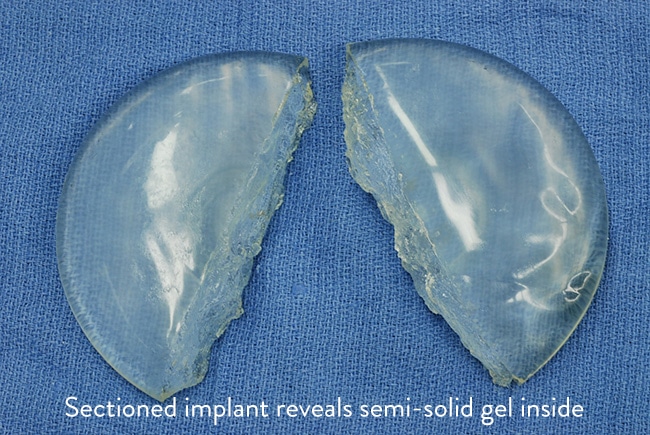
Both implant types are safe. Although there have been claims in the past that there is a relationship between silicone gel filler material and certain rare connective tissue disorders, this has never been proven. The latest studies continue to refute this notion.
Saline and silicone implants of the same size and shape will look exactly the same once implanted. There is no difference between the implant types in this regard. This is an extremely important point to emphasize because many are under the mistaken notion that silicone looks more natural.
Both implant types eventually need to be surgically replaced, usually after ten years or so. This means that multiple replacements will be necessary over one’s lifetime, with more in women who are very young at the time of the initial procedure.
Neither type of implant imposes any restrictions on activity once healing is complete.
Saline vs. Silicone – Differences
The advantages of saline implants are that they do not contain silicone gel and do not require any special tests for long term monitoring. A disadvantage is they are sometimes easier to feel on the side and bottom of the breasts, most commonly in very thin women with scant amounts of breast tissue to begin with. They may also cause visible wrinkles in this same type of individual. Also, saline implants can deflate prematurely after only a few years in about 5 percent, a harmless but inconvenient event that requires implant replacement.
The key advantage of silicone implants is that they feel more natural to the touch, sometimes being completely undetectable due to the nature of the filler material. The main disadvantage is that they require special tests such as an MRI scan in order to monitor shell integrity as the years pass. These scans are not typically covered by insurance.
Saline implants seem to have a better prospect for lasting beyond ten years compared to silicone implants. Clinical experience has shown that saline implants can last as long as twenty years or more with no change in the aesthetics or consistency of the breasts whereas silicone implants have more of a tendency to develop capsular contracture (breast hardening) or silent rupture as they age beyond ten years. Saline implants cost less than silicone implants.
Silicone implants do not completely prevent wrinkles in very thin women with scant amounts of breast tissue. Sometimes they can also exhibit wrinkles, although the tendency is far less than with saline implants. Occasionally silicone implants can exhibit a conspicuous bump or knuckle due to an implant fold, something which does not occur with saline implants. A summary of difference between the two types of implants is shown in the table above.
Round vs. Shaped Implants
There are many implant shapes available today for both saline and silicone implants. These are grouped into two broad categories: round and shaped. The latter are also termed “anatomic” or “tear-drop” types. Shaped implants are commonly used in breast reconstruction after mastectomy, a quite different scenario. The vast majority of plastic surgeons today use round implants for aesthetic breast augmentation. Round implants in the upright position behave like shaped implants in that the filler material migrates to the bottom of the implant, leaving less at the top. While lying down the filler material is evenly distributed and resembles a natural breast shape in that position. A problem unique to shaped implants stems from their asymmetric shape. If they rotate inside the pocket both shape and symmetry can be adversely affected. Definitive correction requires surgery to exchange them for round implants if this occurs. Another drawback of shaped implants is that they can look unnatural when lying down because the volume is not distributed evenly. It is for these reasons that round implants are recommended as the best choice for breast augmentation.
Smooth vs. Rough Surface Implants
Breast implants can have either a rough (textured) or smooth surface. Studies are only weakly suggestive that a textured surface may decrease the chance of capsular contracture. More importantly, textured surfaces may cause a rare type of tumor called anaplastic large cell lymphoma, or ALCL. “Tear drop” shaped implants all have textured surfaces and they have been withdrawn from the market to eliminate this risk. Therefore smooth implants are always used today
Regular vs. High Profile Implants
Breast implants are available in several profiles that determine how much forward projection they have. Implants with equivalent volumes will have a smaller diameter as the profile, or projection, increases. Most patients are best served with moderate (regular) profile implants. Patients that either have a narrow chest, a small breast base diameter (or both) and seek a maximum implant volume are good candidates for a moderate-plus (intermediate height) profile implant. Moderate-plus profile implants are filled tighter than moderate profile implants of the same volume and tend to wrinkle less as a result. They are therefore also a good choice in very thin patients with little breast tissue. High profile implants have a very round, bullet shape and are not used.
Which incision is best?
Breast implants can be placed either through an incision in the armpit, under the breast, or around the lower edge of the areola (Figure 11). An incision around the navel is also an option. However it is extremely challenging to place implants under the muscle with this approach and it is the least popular option.
Incisions can be as short as an inch for saline implants to an inch and a half for silicone implants. As mentioned previously, an armpit (axillary) incision can be used only for saline implants because silicone implants will not pass through the long and narrow channel between the incision and the breast. Saline implants will because they are put in empty and filled once they are in place. The axillary incision is an excellent choice for those who choose saline implants. Women who choose silicone implants are limited to using either an incision around the bottom edge of the areola or one that is under the breast. However, areolar edge incisions have fallen out of favor because there is evidence that the risk of capsular contracture is higher with this incision choice. Therefore incisions under the breast are primarily used for silicone implants. The incisions are placed off to the side within the breast crease where they are least conspicuous.
What pocket plane should be used – over the muscle or under the muscle?
Breast implants can be placed either in front of or behind the pectoral muscle. The muscle is thick and narrow where it forms the fold in front of the armpit. It then becomes thinner as it fans out to attach vertically to the breast bone. Implants placed under the muscle are only partially covered by it because the breast and muscle only partially overlap each other (Figure 12). Implants are easier to feel on the side and bottom of the breast because they lie directly under the skin in these areas. This is why the more viscous silicone implants are often preferred to saline. The latter feel more obvious and sometimes exhibit visible wrinkles on the side and bottom of the breast, particularly in very thin women with scant amounts of breast tissue.
There are three advantages to placing implants behind the muscle. First, the upper breast contour is smoother because the transition between the chest and implant is concealed by muscle padding. Second, multiple studies suggest that there is less tendency for breast hardening, or capsular contracture, to occur when the implant is placed under the muscle. Finally, mammograms are easier to interpret when the implant is under the muscle. It is for these three reasons that implant placement behind the muscle is almost always preferred.
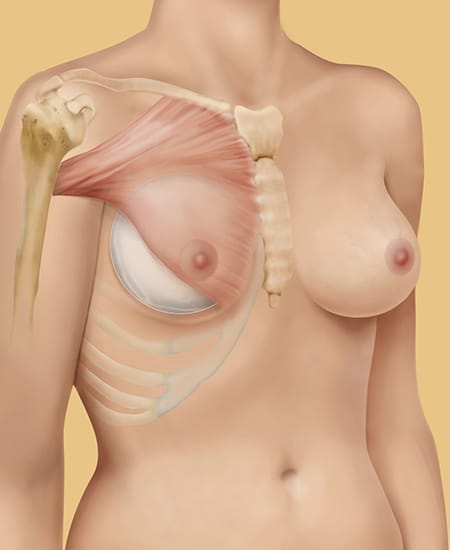
Heavier women who have a lot of breast tissue to begin with and have breasts that either sag or are positioned low on the chest are reasonable candidates for having the implants placed in front of the muscle. There is not much overlap between the muscle and the breast in these cases anyway, and the greater tissue volume conceals the implant shape in the upper part of the breast adequately. Nevertheless, placement of the implant in front of the muscle is not recommended for the vast majority of women.
How is implant size selected?
Implant sizes range from about 100 to 500 ccs. Breast size increases approximately one cup size for each 200 cc added. A natural appearance is one of the most important goals in breast augmentation. The larger the size the more difficult this is to achieve. Implants that range between 200 to 350 cc will typically yield an aesthetically pleasing result. As the volumes increase so does the diameter of the implants. At a certain point overall aesthetics are negatively impacted by implants that not only project too much but are also too wide and tall.
Size selection is guided by a woman’s wishes but is also influenced by height, chest size, and the amount of breast tissue present. Some of the important limiting factors in size selection include tissue quality, low nipple position, and the general shape of the breast: small breast diameters and tight creases under the breast are particularly limiting.
Magazine photographs, cup sizes, and the experiences of friends are not reliable determinants in size selection. Photographic results cannot be measured or standardized and bra cup sizes vary widely from one manufacturer to another. Friends have different breast shapes and starting volumes as well as different physical proportions and aesthetic senses.
The most practical method to simulate the effects of different size implants is to try on various size silicone implants in a larger bra. This is done during a separate appointment that focuses exclusively on this issue. Final size selection is done in collaboration with the surgeon and takes into account physical factors that may argue for either a larger or smaller choice. Typically, one size larger than that selected during the sizing process is used during surgery to compensate for the amount of padding present in the sizing bra. Sometimes, conditions during surgery warrant a slightly different size based on the actual appearance of the preselected size and the surgeon’s aesthetic judgment.
Where is the surgery performed?
Surgery is performed in our office operating room facility and discharge home occurs several hours after the procedure. Breast augmentation generally takes up to two hours and is performed entirety by Dr. Hidalgo.
What type of anesthesia is used?
Breast augmentation requires general anesthesia in order to completely relax the chest muscles and thereby facilitate implant placement. Furthermore, much of the procedure is done in the sitting-up position. Maintenance of airway control in the seated but only partially sedated patient is challenging and not safe.
What is the recovery like?
Aftercare is minimal. Either an elastic binder across the top of the breasts or surgical bra is placed at the time of surgery, the choice depending on the specifics of the procedure. The amount of discomfort is variable but tends to be more when the implants are placed through an armpit incision. Most discomfort subsides within 48 hours. Skin stitches do not require removal. It is usually possible to return to sedentary work after one week. Most normal activities can resume by two weeks. Strenuous physical exercise involving the upper body must be avoided for at least six weeks. Eventually there are no restrictions of any type.
What are the risks associated with breast augmentation surgery?
There are two main issues involving breast implants that prospective patients must be aware of and be comfortable with. First, as mentioned previously, all implants need to be replaced periodically, perhaps as often as every ten years. Second, breast implants can become hard on one or both sides in approximately five percent of women. This condition, called capsular contracture, is due to thickening of the normally thin scar tissue layer that surrounds the implant. The implant itself is not affected. The cause is unknown, although low grade infection and blood in the pocket (hematoma) are suspected. Capsular contracture occurs randomly in 5 percent of women. There are no preventive measures that can be taken other than to quit smoking for those that do.
Capsular contracture can result in breast asymmetry because the affected side becomes rounder and higher. The condition can cause tightness and discomfort when more severe in degree. Significant asymmetry or discomfort usually warrants a second surgical procedure to strip out the scar layer and change the implant. This solves the problem most of the time although it can recur, most commonly in women who are affected by the process on both sides. There is a new, more aggressive surgical remedy using acellular dermal matrix (ADM) available for instances when capsular contracture is resistant to conventional surgical treatment.
Breast augmentation does not affect the ability to breast feed because the implant is located behind the gland. The duct system within the gland is not disturbed, except to a slight degree when an areolar edge incision is used.
Breast augmentation can result in a loss of nipple sensation or sensation in the lower part of the breast skin. This can be either transient or permanent. The location of the incision has no relation to the potential for sensory loss. Rather, loss of sensation is due to the stretching of sensory nerves that can occur in the course of making the implant pocket. Generally speaking, the larger the implant, the more the nerves are stretched, and the greater chance of sensory loss. Fortunately, this does not occur in most women.
All research to date indicates that the risk of breast cancer is not increased in women who have breast augmentation. However, breast implants can make mammograms more difficult to read because the implant obscures some of the tissue and also compresses it. Most experienced radiologists can adequately assess the gland despite this. Self examination is not hindered in any way as a result of breast augmentation.
Some women with breast implants have reported symptoms similar to those of immune system diseases such as systemic lupus erythematosis, rheumatoid arthritis, scleroderma, and other arthritis-like conditions. There has been no scientific evidence to date that shows a cause and effect relationship between breast implants and any of these diseases.
Acute complications from breast augmentation are unusual. Infection or bleeding problems can occur and may require additional surgery. Potential aesthetic problems include implant asymmetry and a palpable implant edge, the latter most often seen in very thin women with saline implants. Most asymmetry problems are minor and do not require correction. A palpable implant edge is often a normal finding, does not pose a health hazard, and typically does not require treatment. Sometimes the implants can ultimately settle out too low and require surgical revision.
What type of long-term implant monitoring is required after surgery?
Saline implants do not require any active monitoring because deflation, a harmless event, is obvious when the implant finally wears out. Rupture of silicone implants is typically a silent event because there is no loss of volume due to the semi-solid nature of the filler material. Therefore silicone implants require active screening with periodic MRI scans to detect failure of the outside shell. The manufacturer recommends the first scan at three years but as a practical matter few silicone implants fail that soon. Our practice therefore recommends that the first MRI scan be obtained seven years after implantation. The study is repeated every other year thereafter until a shell change suggesting implant replacement is demonstrated.
What are the costs involved in breast augmentation?
There are separate surgical, anesthesia, operating room, and implant fees associated with breast augmentation. Fees for replacing a deflated saline implant are partially reimbursed by the implant company in most cases. The surgical fee for treating capsular contracture that occurs within the first year or two is also reduced. Implants that are replaced many years later are subject to normal fees. Requests for a size change are accompanied by normal fees but this rarely occurs when the preoperative sizing technique described above is used.
What are the steps involved in proceeding with breast augmentation?
The first step is to schedule an initial consultation. This visit focuses on goals, candidacy for the procedure, and designing an individual surgical plan. A sizing appointment is then scheduled as the next step. Photographs and a few lab tests are subsequently obtained prior to surgery.
